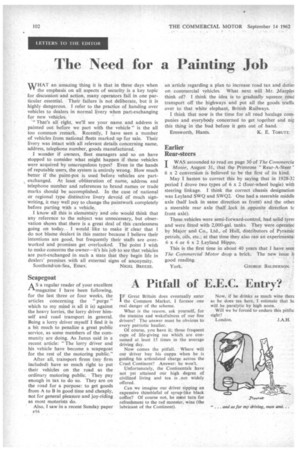The Need for a Painting Job
Page 104

If you've noticed an error in this article please click here to report it so we can fix it.
WHAT an amazing thing it is that in these days when " the emphasis on all aspects of security is a key topic for discussion and action, many operators fail in one particular essential. Their failure is not deliberate, but it is highly dangerous. I refer to the practice of handing over vehicles to dealers in normal livery when part-exchanging for new vehicles.
'" That's all right, we'll see your name and address is painted out before we part with the vehicle " is the all too common remark. Recently, I have seen a number of vehicles from national fleets marked up for sale. Their livery was intact with all relevant details concerning name, address, telephone number, goods manufactured.
I wonder if owners, fleet managers and so on have stopped to consider what might happen if these vehicles were acquired by unscrupulous types? Even in the hands of reputable users, the system is entirely wrong. How much better if the paint-pot is used before vehicles are partexchanged. At least obliteration of name, address and telephone number and references to brand names or trade marks should be accomplished. In the case of national or regional type distinctive livery devoid of much signwriting, it may well pay to change the paintwork completely before parting with a vehicle.
I know all this is elementary ,and one would think that any reference to the subject was unnecessary, but observation shows that there is a great deal of this carelessness going on today.. I would like to make it clear that I do not blame dealers in this matter because I believe their intentions are good, but frequently their staffs are overworked and promises get overlooked. The point I. wish to make concerns the owner—it's his job to see that vehicles are part-exchanged in such a state that they begin life in dealers' premises with all external signs of anonymity.
Southend-on-Sea, Essex. NiGEL BREEZE,
Scapegoat
A S a regular reader of your excellent 1-1-magazine I have been following, for the last three or four weeks, the articles concerning the " purge " which to my mind is all it is) against the heavy lorries, the lorry driver himself and road transport in general. Being a lorry driver myself I find it is a bit much to penalize a great public service, as some members of the community are doing. As Janus said in a recent article: "The lorry driver and his vehicle have become a scapegoat for the rest of the motoring public."
After all, transport firms (my firm included) have as much right to put their vehicles on the road as the ordinary motoring public. They pay enough in tax to do so. They are on the road for a purpose: to get goods from A to B in good time and cheaply, not for general pleasure and joy-riding as most motorists do.
Also, I saw in a recent Sunday paper F16
an article regarding a plan to increase road tax and dutie on commercial vehicles. What next will Mr. ,Marple think of? I think the idea is to gradually squeeze road transport off the highways and put all the goods traffi( over to that white elephant, British Railways.
I think that now is the time for all road haulage companies and everybody concerned to get together and nip this thing in the bud before it gets out of hand.
Emsworth, Hants. K. E. Toaurr.
Earlier Rear-steers
T WAS astounded to read on page 30 of The Commercia -IMotor, August 31, that the Primrose " Rear-A-Steer ' 6 x 2 conversion is believed to be the first of its kind.
May I hasten to correct this by saying that in 1928-32 period I drove two types of 6 x 2 (four-wheel bogie) witIn steering linkage. I think the correct chassis designation was Leyland SWQ and SWQ2. One had a steerable middlc axle (half lock in same direction as front) and the othei a steerable rear axle (half lock in opposite direction tc front axle).
These .vehicles were semi-forward-control, had solid tyres and were fitted with 2,000-gal. tanks. They were operatee by Major and Co., Ltd., of Hull, distributors of Pyramic petrols; oils, etc.; at that time they also ran an experimental 6 x 4 or 6 x 2 Leyland Hippo.
This is the first time in about 40 years that I have seen The Commercial Motor drop a brick. The new issue is good reading.
York. GEORGE BALDERSON„
















































































































































































































































